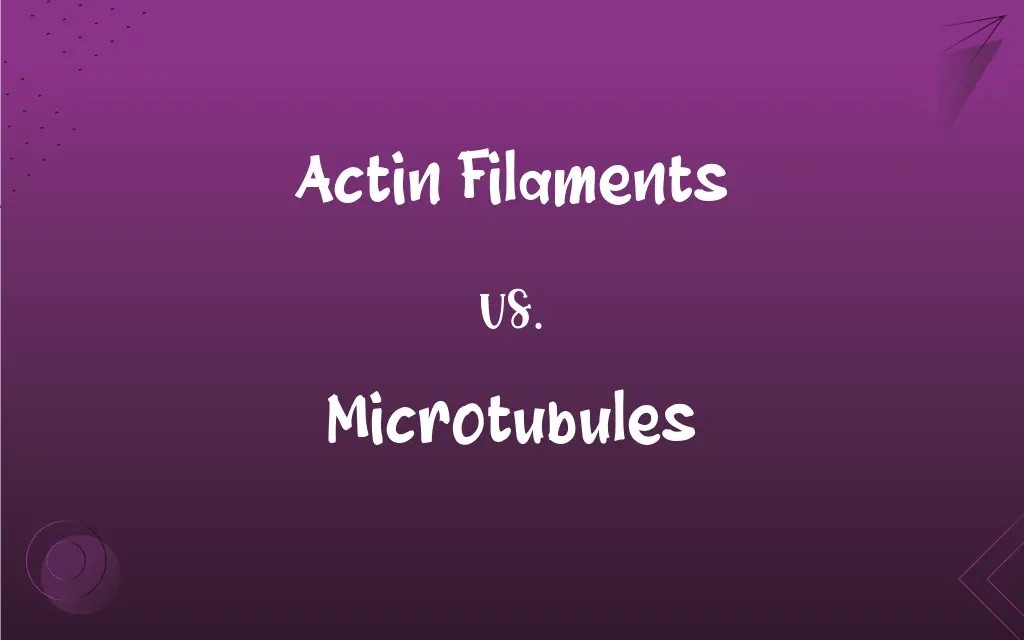Actin Filaments vs. Microtubules: What's the Difference?
Edited by Aimie Carlson || By Janet White || Published on January 25, 2024
Actin filaments are thin protein fibers crucial for cell movement and shape; microtubules are thicker tubes vital for cell division and intracellular transport.

Key Differences
Actin filaments, composed of actin protein, are thin, flexible fibers forming part of the cytoskeleton. Microtubules, larger and more rigid, are composed of tubulin proteins, forming hollow tubes that also contribute to the cytoskeleton.
Actin filaments are primarily involved in muscle contraction, cell movement, and maintaining cell shape. Microtubules are crucial for cell division (mitosis and meiosis), moving chromosomes, and transporting materials within cells.
Actin filaments exhibit dynamic instability but are generally more stable and less prone to rapid disassembly than microtubules. Microtubules undergo rapid assembly and disassembly, a process essential for their function in cell division.
Actin filaments often form networks and are concentrated just beneath the cell membrane, providing structural support. Microtubules extend from the centrosome, organizing the cell’s interior and guiding organelle placement.
Actin filaments interact with myosin for muscle contraction and are involved in forming cell junctions. Microtubules interact with motor proteins like kinesin and dynein, facilitating intracellular transport.
ADVERTISEMENT
Comparison Chart
Protein Composition
Actin
Tubulin
Primary Functions
Cell movement, muscle contraction, shape maintenance
Cell division, intracellular transport
Structural Characteristics
Thin, flexible fibers
Thick, hollow tubes
Stability and Dynamics
More stable, less prone to disassembly
Rapid assembly and disassembly
Cellular Localization
Beneath cell membrane, forming networks
Extend from centrosome, organizing cell interior
ADVERTISEMENT
Actin Filaments and Microtubules Definitions
Actin Filaments
Thin strands forming the cell's cytoskeleton.
The actin filaments maintain the shape of the cell during division.
Microtubules
Composed of tubulin protein subunits.
The dynamic assembly of microtubules involves the addition and removal of tubulin.
Actin Filaments
Play a role in muscle contraction with myosin.
Muscle contraction is driven by the interaction of actin filaments and myosin.
Microtubules
Larger components of the cytoskeleton.
Microtubules provide structural support to eukaryotic cells.
Actin Filaments
Contribute to cellular structure and integrity.
Actin filaments provide structural support beneath the cell membrane.
Microtubules
Originate from the centrosome in cells.
The microtubules radiate out from the centrosome to organize the cell's interior.
Actin Filaments
Composed of polymerized actin protein.
Actin filaments grow by adding more actin monomers.
Microtubules
Tubular structures important for cell division.
Microtubules form the spindle fibers during mitosis.
Actin Filaments
Protein fibers involved in cell movement.
Actin filaments facilitate the contraction of muscle cells.
Microtubules
Facilitate transport within cells.
Organelles move along microtubules with the help of motor proteins.
Microtubules
Any of the cylindrical hollow tubulin-containing structures that are found in the cytoplasm, cilia, and flagella of eukaryotic cells and are involved in determining cell shape and structure and directing the movement of organelles and chromosomes. Microtubules, along with microfilaments and intermediate filaments, make up a cell's cytoskeleton.
Microtubules
Plural of microtubule
FAQs
What role do microtubules play in cell division?
They form spindle fibers that separate chromosomes.
What are microtubules?
Tubular structures in cells, composed of tubulin proteins.
What are actin filaments?
Thin fibers in cells, made of actin protein.
How do actin filaments support cell movement?
They interact with myosin to facilitate movement and contraction.
Do actin filaments participate in cell division?
They're involved in cytokinesis, the final step of cell division.
How do microtubules help in intracellular transport?
They act as tracks for motor proteins carrying organelles.
Can actin filaments form networks?
Yes, they often form complex networks beneath the cell membrane.
What is the primary function of microtubules?
To maintain cell shape, cell division, and intracellular transport.
Where are microtubules most commonly found in a cell?
Extending from the centrosome throughout the cell.
How do actin filaments affect cell shape?
They provide structural support to maintain cell shape.
Are actin filaments involved in muscle contraction?
Yes, they're key components in muscle fibers.
What is the dynamic instability of microtubules?
Rapid assembly and disassembly of tubulin subunits.
How are actin filaments assembled?
Through polymerization of actin monomers.
Are actin filaments flexible or rigid?
They are relatively flexible and resilient.
Do microtubules interact with other cellular components?
Yes, particularly with motor proteins like kinesin and dynein.
Can actin filaments be found in all cell types?
They are present in most eukaryotic cells.
What is the role of microtubules in neurons?
They support axon and dendrite structure and transport materials.
Do microtubules have a role in cellular signaling?
Indirectly, by organizing the cell and facilitating transport.
Can actin filaments be disassembled?
Yes, they can dynamically assemble and disassemble.
What is the difference in size between actin filaments and microtubules?
Actin filaments are thinner than microtubules.
About Author
Written by
Janet WhiteJanet White has been an esteemed writer and blogger for Difference Wiki. Holding a Master's degree in Science and Medical Journalism from the prestigious Boston University, she has consistently demonstrated her expertise and passion for her field. When she's not immersed in her work, Janet relishes her time exercising, delving into a good book, and cherishing moments with friends and family.
Edited by
Aimie CarlsonAimie Carlson, holding a master's degree in English literature, is a fervent English language enthusiast. She lends her writing talents to Difference Wiki, a prominent website that specializes in comparisons, offering readers insightful analyses that both captivate and inform.

































































